Vitamin D
Filter
-
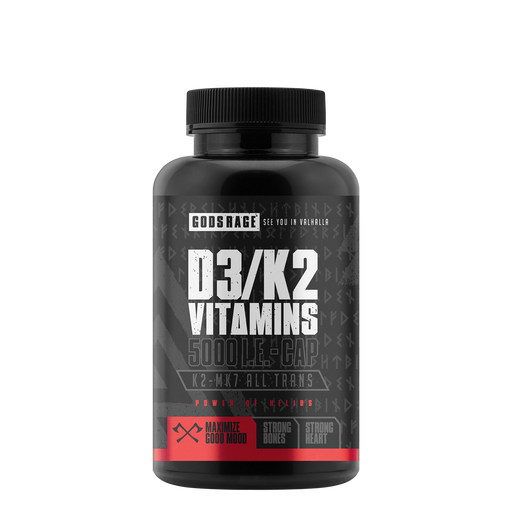 Ausverkauft
Original-Preis €19,90 - Original-Preis €19,90Original-Preis €19,90€19,90€19,90 - €19,90Aktueller Preis €19,90|/
Ausverkauft
Original-Preis €19,90 - Original-Preis €19,90Original-Preis €19,90€19,90€19,90 - €19,90Aktueller Preis €19,90|/D3/K2 Vitamins Gods Rage · 90 Kapseln
Gods Rage29 reviewsVitamin D3/K2 bringt eine ganze Reihe an Vorteilen für deine Gesundheit mit sich. Sowohl dein Immunsystem als auch deine Zähne, Knochen und auch de...
Vollständige Details anzeigenOriginal-Preis €19,90 - Original-Preis €19,90Original-Preis €19,90€19,90€19,90 - €19,90Aktueller Preis €19,90|/Ausverkauft -
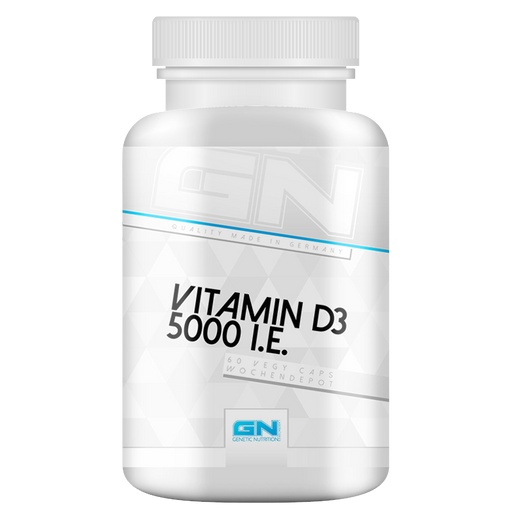 Jetzt 0% sparen
Jetzt % sparen
Original-Preis €12,90 - Original-Preis €12,90Original-Preis €12,90€12,90€12,90 - €12,90Aktueller Preis €12,90|/
Jetzt 0% sparen
Jetzt % sparen
Original-Preis €12,90 - Original-Preis €12,90Original-Preis €12,90€12,90€12,90 - €12,90Aktueller Preis €12,90|/Vitamin D3 5000IE · 60 Kapseln
GN Laboratories13 reviewsVitamin D3 kann dein allgemeines Wohlbefinden und deine Gesundheit durch eine Unmenge positiver Effekte unterstützen. Dein Immunsystem, die Struktu...
Vollständige Details anzeigenOriginal-Preis €12,90 - Original-Preis €12,90Original-Preis €12,90€12,90€12,90 - €12,90Aktueller Preis €12,90|/Jetzt 0% sparen Jetzt % sparen -
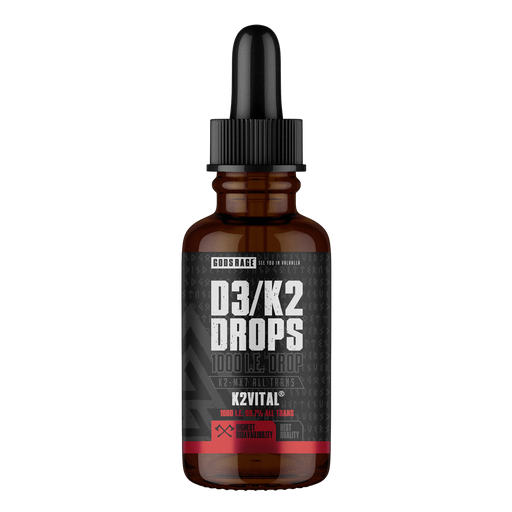 Jetzt 11% sparen
Jetzt % sparen
Original-Preis €24,90Original-Preis €24,90 - Original-Preis €24,90Original-Preis €24,90Aktueller Preis €22,16€22,16 - €22,16Aktueller Preis €22,16|/
Jetzt 11% sparen
Jetzt % sparen
Original-Preis €24,90Original-Preis €24,90 - Original-Preis €24,90Original-Preis €24,90Aktueller Preis €22,16€22,16 - €22,16Aktueller Preis €22,16|/D3/K2 Drops · 50ml
Gods Rage28 reviewsDie Vitamine D3 und K2 können deine Gesundheit und dein Wohlbefinden durch zahlreiche Effekte positiv beeinflussen. Das Immunsystem, die Zähne und ...
Vollständige Details anzeigenOriginal-Preis €24,90Original-Preis €24,90 - Original-Preis €24,90Original-Preis €24,90Aktueller Preis €22,16€22,16 - €22,16Aktueller Preis €22,16|/Jetzt 11% sparen Jetzt % sparen -
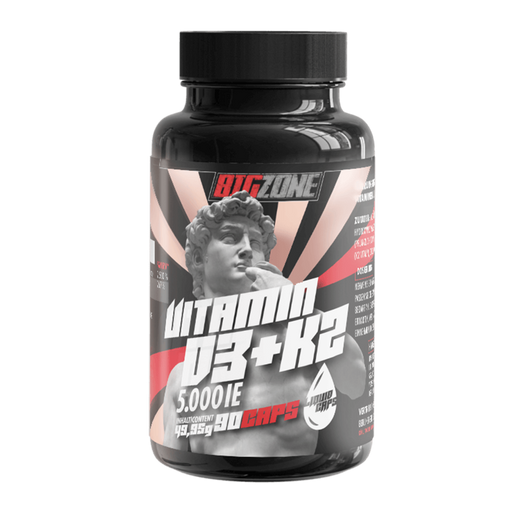 Jetzt 0% sparen
Jetzt % sparen
Original-Preis €24,90 - Original-Preis €24,90Original-Preis €24,90€24,90€24,90 - €24,90Aktueller Preis €24,90|/
Jetzt 0% sparen
Jetzt % sparen
Original-Preis €24,90 - Original-Preis €24,90Original-Preis €24,90€24,90€24,90 - €24,90Aktueller Preis €24,90|/Vitamin D3 + K2 · 90 Liquid Caps
Big Zone3 reviewsVitamin D trägt zu einer normalen Funktion des Immunsystems bei Vitamin D trägt zur Erhaltung einer normalen Muskelfunktion Vitamin D trägt zur Er...
Vollständige Details anzeigenOriginal-Preis €24,90 - Original-Preis €24,90Original-Preis €24,90€24,90€24,90 - €24,90Aktueller Preis €24,90|/Jetzt 0% sparen Jetzt % sparen -
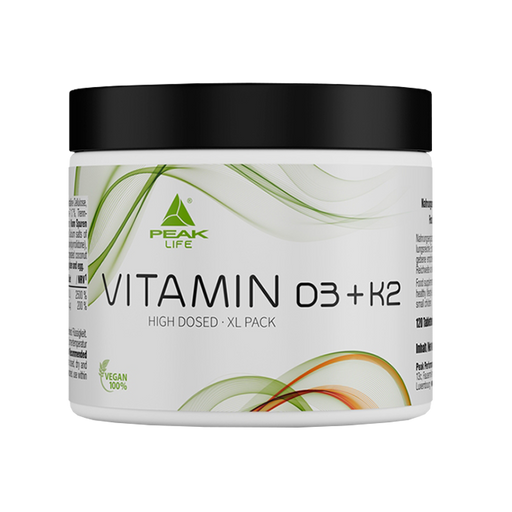 Jetzt 0% sparen
Jetzt % sparen
Original-Preis €19,90 - Original-Preis €19,90Original-Preis €19,90€19,90€19,90 - €19,90Aktueller Preis €19,90|/
Jetzt 0% sparen
Jetzt % sparen
Original-Preis €19,90 - Original-Preis €19,90Original-Preis €19,90€19,90€19,90 - €19,90Aktueller Preis €19,90|/Vitamin D3 + K2 · 120 Tabletten
PEAK3 reviewsVitamin D3 + K2 - wichtig für Knochen, Immunsystem und Muskeln Hohe Dosierung 5000 I.U. (125 µg) Vitamin D + 150 µg Vitamin K pro Tablette Hohe Bi...
Vollständige Details anzeigenOriginal-Preis €19,90 - Original-Preis €19,90Original-Preis €19,90€19,90€19,90 - €19,90Aktueller Preis €19,90|/Jetzt 0% sparen Jetzt % sparen -
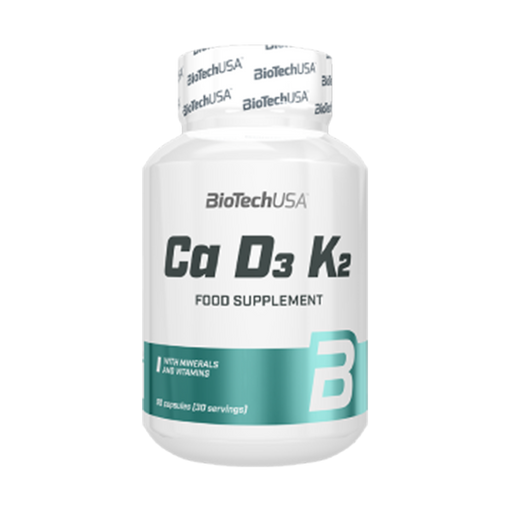 Jetzt 0% sparen
Jetzt % sparen
Original-Preis €10,90 - Original-Preis €10,90Original-Preis €10,90€10,90€10,90 - €10,90Aktueller Preis €10,90|/
Jetzt 0% sparen
Jetzt % sparen
Original-Preis €10,90 - Original-Preis €10,90Original-Preis €10,90€10,90€10,90 - €10,90Aktueller Preis €10,90|/Ca-D3-K2 · 90 Kapseln
Biotech USA2 reviewsKomplexe Zusammensetzung mit Calcium, Phosphor, Vitamin D3 und Vitamin K2 Ökonomische Verpackung Einfache Anwendung Calcium für Erhaltung normaler...
Vollständige Details anzeigenOriginal-Preis €10,90 - Original-Preis €10,90Original-Preis €10,90€10,90€10,90 - €10,90Aktueller Preis €10,90|/Jetzt 0% sparen Jetzt % sparen -
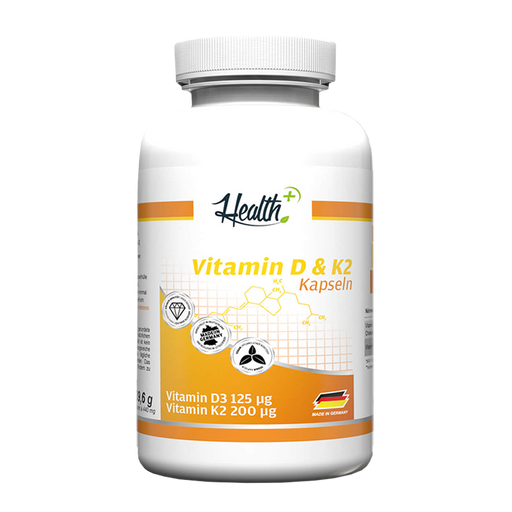 Ausverkauft
Original-Preis €19,90 - Original-Preis €19,90Original-Preis €19,90€19,90€19,90 - €19,90Aktueller Preis €19,90|/
Ausverkauft
Original-Preis €19,90 - Original-Preis €19,90Original-Preis €19,90€19,90€19,90 - €19,90Aktueller Preis €19,90|/Vitamin D3 & K2 Health+ · 90 Kapseln
Zec+1 reviewSynergistische Kombination: HEALTH+ Vitamin D3 & K2 Kapseln bieten umfassende Gesundheitsvorteile durch die effektive Verbindung von 5000 IU ...
Vollständige Details anzeigenOriginal-Preis €19,90 - Original-Preis €19,90Original-Preis €19,90€19,90€19,90 - €19,90Aktueller Preis €19,90|/Ausverkauft -
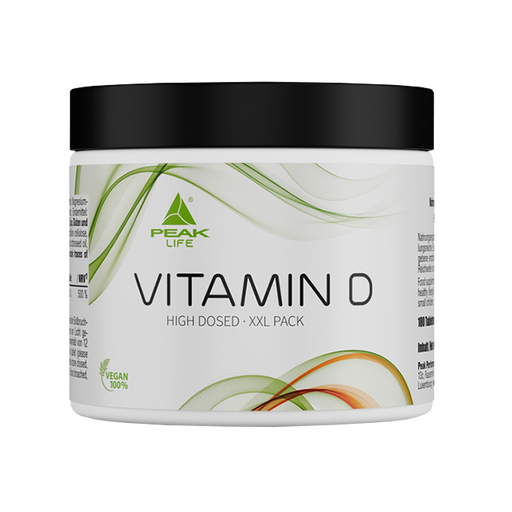 Jetzt 0% sparen
Jetzt % sparen
Original-Preis €9,90 - Original-Preis €9,90Original-Preis €9,90€9,90€9,90 - €9,90Aktueller Preis €9,90|/
Jetzt 0% sparen
Jetzt % sparen
Original-Preis €9,90 - Original-Preis €9,90Original-Preis €9,90€9,90€9,90 - €9,90Aktueller Preis €9,90|/Vitamin D · 180 Tabletten
PEAK3 reviewsVitamin D3 - wichtig für Knochen, Immunsystem und Muskeln 2000 I.U. hochbioverfügbares Vitamin D3 pro Tablette Fördert die Erhaltung normaler Knoc...
Vollständige Details anzeigenOriginal-Preis €9,90 - Original-Preis €9,90Original-Preis €9,90€9,90€9,90 - €9,90Aktueller Preis €9,90|/Jetzt 0% sparen Jetzt % sparen -
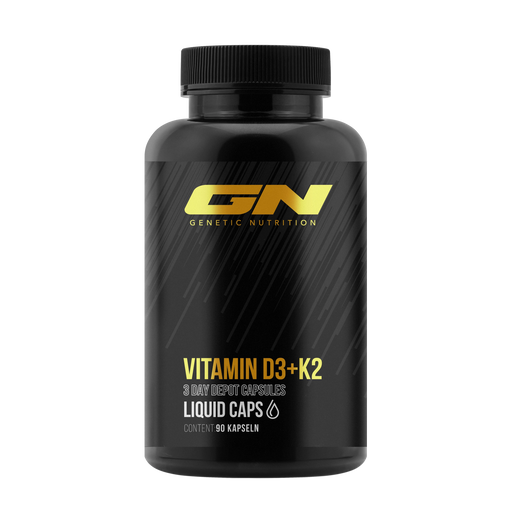 Jetzt 0% sparen
Jetzt % sparen
Original-Preis €24,90 - Original-Preis €24,90Original-Preis €24,90€24,90€24,90 - €24,90Aktueller Preis €24,90|/
Jetzt 0% sparen
Jetzt % sparen
Original-Preis €24,90 - Original-Preis €24,90Original-Preis €24,90€24,90€24,90 - €24,90Aktueller Preis €24,90|/Vitamin D3+K2 · 90 Liquid caps
GN Laboratories2 reviewsHochwirksame Kombination: Vitamin D3+K2 Liquid caps von GN nutzen Vitamin D3 und Markenrohstoff K2Vital® für optimale Knochen- und Zahngesundheit...
Vollständige Details anzeigenOriginal-Preis €24,90 - Original-Preis €24,90Original-Preis €24,90€24,90€24,90 - €24,90Aktueller Preis €24,90|/Jetzt 0% sparen Jetzt % sparen -
 Jetzt 0% sparen
Jetzt % sparen
Original-Preis €19,90 - Original-Preis €19,90Original-Preis €19,90€19,90€19,90 - €19,90Aktueller Preis €19,90|/
Jetzt 0% sparen
Jetzt % sparen
Original-Preis €19,90 - Original-Preis €19,90Original-Preis €19,90€19,90€19,90 - €19,90Aktueller Preis €19,90|/Gold Omega 3 D3+K2 Sport Edition · 60 Kapseln
Olimp Sport NutritionNo reviewsProdukt: Gold Omega 3 D3+K2 Sport Edition - reichhaltiges Nahrungsergänzungsmittel mit Omega-3, Vitamin D3 und K2. Omega-3: Aus Kaltwasserfisch...
Vollständige Details anzeigenOriginal-Preis €19,90 - Original-Preis €19,90Original-Preis €19,90€19,90€19,90 - €19,90Aktueller Preis €19,90|/Jetzt 0% sparen Jetzt % sparen -
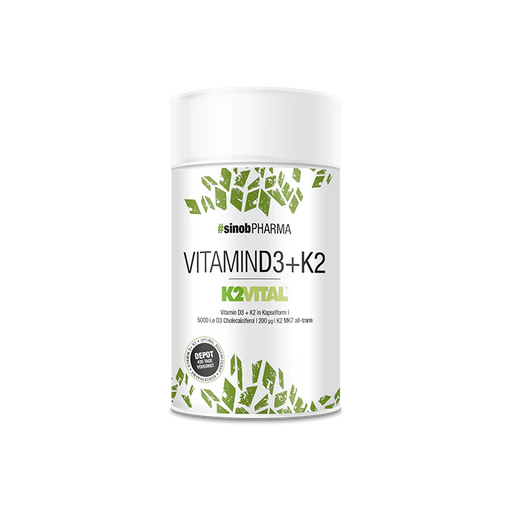 Jetzt 0% sparen
Jetzt % sparen
Original-Preis €19,90 - Original-Preis €19,90Original-Preis €19,90€19,90€19,90 - €19,90Aktueller Preis €19,90|/
Jetzt 0% sparen
Jetzt % sparen
Original-Preis €19,90 - Original-Preis €19,90Original-Preis €19,90€19,90€19,90 - €19,90Aktueller Preis €19,90|/Vitamin D3+K2 · 60 Kapseln
#sinobNo reviewsEssenzielle Vitamine: Vitamin D3 und K2 sind lebenswichtige, fettlösliche Vitamine. Sonnensynthese: Vitamin D kann bei ausreichender Sonneneins...
Vollständige Details anzeigenOriginal-Preis €19,90 - Original-Preis €19,90Original-Preis €19,90€19,90€19,90 - €19,90Aktueller Preis €19,90|/Jetzt 0% sparen Jetzt % sparen -
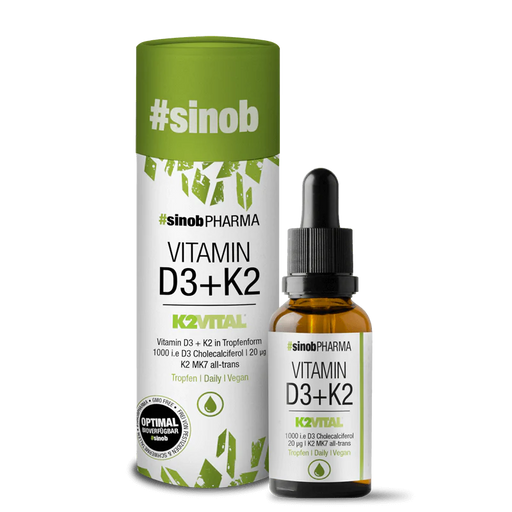 Jetzt 11% sparen
Jetzt % sparen
Original-Preis €16,90Original-Preis €16,90 - Original-Preis €16,90Original-Preis €16,90Aktueller Preis €15,04€15,04 - €15,04Aktueller Preis €15,04|/
Jetzt 11% sparen
Jetzt % sparen
Original-Preis €16,90Original-Preis €16,90 - Original-Preis €16,90Original-Preis €16,90Aktueller Preis €15,04€15,04 - €15,04Aktueller Preis €15,04|/Vitamin D3 + K2 Tropfen · 10ml
#sinobNo reviewsVitamin D Wichtigkeit: Essentiell für Knochen, Muskeln, Immunsystem. Vitamin D3 + K2 Tropfen von #SINOB: Praktische Lösung gegen Vitamin D-Mang...
Vollständige Details anzeigenOriginal-Preis €16,90Original-Preis €16,90 - Original-Preis €16,90Original-Preis €16,90Aktueller Preis €15,04€15,04 - €15,04Aktueller Preis €15,04|/Jetzt 11% sparen Jetzt % sparen -
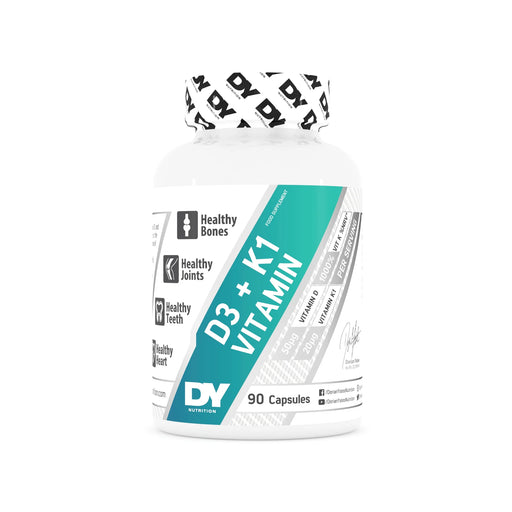 Jetzt 0% sparen
Jetzt % sparen
Original-Preis €12,90 - Original-Preis €12,90Original-Preis €12,90€12,90€12,90 - €12,90Aktueller Preis €12,90|/
Jetzt 0% sparen
Jetzt % sparen
Original-Preis €12,90 - Original-Preis €12,90Original-Preis €12,90€12,90€12,90 - €12,90Aktueller Preis €12,90|/Vitamin D3 + K1 · 90 Kapseln
DY NutritionNo reviewsVitamin D und K1 sind entscheidend für ein starkes Immunsystem und gesunde Knochen. Erhöht die Bioverfügbarkeit und Absorption im Vergleich zur ...
Vollständige Details anzeigenOriginal-Preis €12,90 - Original-Preis €12,90Original-Preis €12,90€12,90€12,90 - €12,90Aktueller Preis €12,90|/Jetzt 0% sparen Jetzt % sparen
Vitamin D bzw. Calciferole ist ein Sammelbegriff für verschiedene Stoffe (Steroide), die im eigentlichen Sinn den Hormonen zuzuschreiben sind. Sie können vom menschlichen Organismus aus Cholesterin in der Haut durch Sonneneinstrahlung gebildet werden. Das in der Haut durch Sonneneinstrahlung gebildete Vitamin aus Cholesterin ist das Vitamin D3 oder auch Cholecalciferol. Das aus Pflanzen stammende Provitamin D, Ergosterin wird ebenfalls durch Photolyse in der Haut umgewandelt. Es trägt die Bezeichnung Ergocalciferol bzw. Vitamin D2. Cholecalciferol und Ergocalciferol besitzen die gleiche Wirksamkeit.
Das Vorkommen in Lebensmitteln ist insgesamt sehr niedrig. In den meisten pflanzlichen Lebensmitteln befindet sich kein vorgefertigtes Vitamin D. Eine Ausnahme bilden Pilze, Spinat, einige Kohlarten und Hefe. Dort ist Ergocalciferol in verhältnismäßig großen Mengen vorhanden. In Lebensmitteln tierischen Ursprungs, sind nur in fettreichen Fischen (Lachs, Forelle, Thunfisch, Hering, usw.) größere Mengen an Cholecalciferol zu finden. Vitamin D ist relativ hitzestabil, wodurch bei der Zubereitung (Blanchieren oder Braten) von Vitamin-D-haltigen Lebensmittel kaum mit Garverlusten dieses Vitamins zu rechnen ist. Gegenüber Sauerstoff und Licht ist es sehr instabil. Lange Lagerzeiten, besonders im Hellen setzen die Bioverfügbarkeit des Vitamins herab.
Stoffwechsel
Vitamin D wird vorallem in der Leber gespeichert. Dort und zum Teil auch in der Niere und im Darm wird Vitamin D3 weiter zu einem Stoff (D-Hormon bzw. Calcitriol) umgewandelt. Dieser Stoff ist für die Regelung des Calciumstoffwechsels verantwortlich.
Aufgaben
Vitamin D ist Bestandteil des endokrinen Systems und dort für die Regulierung des Calcium- und Phosphatstoffwechsels verantwortlich. Vitamin D steuert die Calciumresorption (Aufnahme) aus dem Darm, bei einem Absinken des Blutcalciumspiegels.
In vielen Geweben, wie Geschlechtsdrüsen, Herz, Pankreas (Bauchspeicheldrüse) und Schilddrüse sitzen Rezeptoren für Calcitriol (D-Hormon; ein Vitamin-D-Metabolid). Doch welche Aufgaben das Hormon dort besitzt, oder wie es diese Gewebe beeinflusst, ist noch weitgehend unbekannt.
Vorkommen
Vitamin D bildet sich durch UV-Strahlung (Sonnenlicht!) aus Vorstufen (z.B. 7-Dehydrocholesterol, Ergosterol), den sogenannten Provitaminen. Nur wenige Nahrungsmittel enthalten Vitamin D. Es findet sich in Lebertran und -öl, Hering und Eigelb. Besonders reiche Vitamin D-Quellen (μg/100g)
- Sardine 7,05
- Hering 31
- Lachs 16
- Kabeljau 1,3
- Leber (Geflügel) 1,3
- Leber (Rind) 1,7
- Kalbfleisch 3,8
- Lebertran 330
- Dorschleberöl 210 10. Ei 3,5
In Pflanzen ist Ergosterol enthalten, während in tierischen Geweben 7-Dehydrocholesterol vorkommt. Beide Verbindungen können sich bei ausreichender UV-Licht Bestrahlung in biologisch aktive Substanzen umwandeln, die wir unter dem Begriff Vitamin D zusammenfassen.
Gesundheitsvorzüge von Vitamin D
Vitamin D kann eine Osteomalzie (Knochenerweichung) verhindern und die Gesundheit der Knochen fördern
Vitamin D hält das Gleichgewicht von Kalzium und Phosphor im Körper aufrecht. Genauer gesagt fördert Vitamin D die Absorption von Kalium und Phosphor im Verdauungstrakt, die Kalzium Wiederaufnahme in den Nieren und die Kalziummobilisierung in den Knochen (1, 2, 3). Niedrige Vitamin D Spiegel werden mit einer niedrigeren Knochenmineraldichte, einer unzureichenden Knochenmineralisierung und einem erhöhten Risiko für Knochenabbau und Frakturen in Verbindung gebracht. Wissenschaftliche Untersuchungen unterstützen die Rolle von Vitamin D und Kalzium Supplements zur Unterstützung der Knochengesundheit und für eine Reduzierung des Risikos für Knochenbrüche (5, 6, 7, 8). Ein Vitamin D Mangel kann bei jungen Kindern Rachitis und bei Erwachsenen eine Osteomalzie (Knochenerweichung) hervorrufen. Beides kann durch eine ausreichende Zufuhr von Vitamin D über die Nahrung verhindert werden (11, 12). Hierfür sollte versucht werden, Vitamin D Blutspiegel im Bereich von 20 bis 50 mg/nl zu erreichen (4).
Vitamin D kann vor Osteoporose schützen
Zusammen mit Kalzium Supplements können Vitamin D Supplements dabei helfen, ältere Erwachsene vor Osteoporose zu schützen (9). Zusätzlich hierzu kann oral eingenommenes Vitamin D Osteoporose durch Kortikosteroid Medikamente, die zur Linderung schwerer Entzündungen verschrieben werden, verhindern. Untersuchungen legen nahe, dass Vitamin D Stoffwechselprodukte wie Calcitriol und Alfacalcidol hierfür am effektivsten sind (10).
Vitamin D kann die Funktion des Immunsystems unterstützen
Studien haben gezeigt, dass Vitamin D starke Auswirkungen auf sowohl die angeborene, als auch die adaptive Immunität besitzt. Vitamin D besitzt das Potential eine große Bandbreite von Ungleichgewichten der Immunfunktion, Infektionen und Autoimmunerkrankungen positiv zu beeinflussen (13, 14).Zellen wie Makrophagen, Dendritzellen, T-Zellen und B-Zellen, die an der Immunreaktion beteiligt sind, weisen Rezeptoren für Vitamin D auf (15, 16).
Hier ist ein Überblick über einige der Auswirkungen von Vitamin D auf das Immunsystem:
- Regulierung der Aktivität von Monozyten und Makrophagen (17, 18)
- Reduziert die Ausschüttung der entzündungsfördernden Zytokine IL-1, IL-2, IL-6, IL-8, IL-17, TNF-α, IFN-γ und IL-12 (19, 20, 21)
- Erhöht die Ausschüttung der entzündungshemmenden Zytokine IL-10 und IL-4 (22, 23)
- Hemmt die Produktion von IgE durch B Zellen und erhöht die Produktion von IL-10 durch Dendritzellen und T-Zellen, was bei allergischen Immunreaktionen eine wichtige Rolle spielt (24, 25)
- Reduziert die TFG-beta Spiegel, was zur Gewebereparatur beiträgt (26, 27)
- Ist entscheidend für die Aktivierung von T-Zellen (28)
- Erhöht die Mengen an CD8+ T-Zellen, was zur Kontrolle von Viren, Bakterien und Krebs wichtig ist (29, 30)
- Erhöht die Menge an natürlichen T-Killerzellen (31)
- Regt die Freisetzung antimikrobieller Verbindungen wie Cathelicidin und beta-Defensin 4 in Reaktion von Infektionen an (32, 33)
All diese Ergebnisse legen nahe, dass Vitamin D dabei hilft, eine gesunde Immunreaktion aufrecht zu erhalten. Es reduziert entzündungsfördernde Botenstoffe und erhöht die Spiegel entzündungshemmender Verbindungen.
Vitamin D kann vor Infektionen der Atemwege schützen
Wissenschaftler haben herausgefunden, dass Menschen, die unter einem Vitamin D Mangel leiden, mit größerer Wahrscheinlichkeit an Erkrankungen von Atemwegen und Lunge bis hin zu Tuberkulose erkranken. Begrenzte Untersuchungen legen nahe, dass eine Supplementation mit Vitamin D sogar Tuberkulose verhindern oder die Krankheitsdauer reduzieren könnte, indem sie das Immunsystem stärkt (34, 35, 36). Eine Reihe von Studien hat außerdem gezeigt, dass eine Vitamin D Supplementation - insbesondere während der Wintermonate – Kinder vor Grippe und Infektionen der Atemwege schützt. Was Erwachsene angeht, bedarf es hierfür weiterer Untersuchungen (37, 38, 39). Zusätzlich hierzu leiden Menschen, die an HIV erkrankt sind, häufig unter einem Vitamin D Mangel, was ihre Immunreaktion weiter schwächen kann. Einige Hinweise deuten darauf hin, dass eine Supplementation die Immunfunktion und den Vitamin D Status dieser Patienten auf sichere Art und Weise verbessern kann (40, 41, 42).
Vitamin D kann Entzündungen und Autoimmunerkrankungen lindern
Vitamin D hilft dabei, Entzündungen im Körper zu reduzieren. Studien haben gezeigt, dass es die Immunfunktion ins Gleichgewicht bringen kann. Vitamin D besitzt das Potential eine große Bandbreite an Immunproblemen, Infektionen und Autoimmunerkrankungen positiv zu beeinflussen (43, 44). Das Potential von Vitamin D, die Spiegel regulatorischer T-Zellen zu erhöhen, könnte besonders wichtig sein, da regulatorische T-Zellen Immunzellen sind, die verhindern, dass das Immunsystem außer Kontrolle gerät. Diese Zellen können sowohl allergische Reaktionen, als auch Autoimmuntendenzen verhindern (45).
Bisher deuten einige Studien auf vielversprechende Wirkungen von Vitamin D bei folgenden entzündlichen und/oder Autoimmunerkrankungen hin:
- Multiple Sklerose (46, 47)
- Schilddrüsenprobleme (48, 49)
- Lupus (50, 51)
- Rheumatische Arthritis (52)
- Reizdarmsyndrom (53, 54
- Chronisch obstruktive Lungenerkrankungen (55, 56)
- Typ 1 Diabetes (57, 58)
- Asthma (59, 60)
Alles in allem haben Studien bestätigt, dass ein Vitamin D Mangel bei Menschen, die unter Autoimmunerkrankungen, entzündlichen Erkrankungen und allergischen Problemen leiden, weiter verbreitet ist.
Vitamin D kann gegen niedrige Kalziumspiegel bei Nierenerkrankungen helfen
Eine orale Vitamin D Supplementation kann bei Menschen die unter chronischem Nierenversagen leiden und sich einer Dialyse unterziehen müssen, effektiv niedrige Kalziumspiegel kontrollieren und Komplikationen wie eine renale Osteodystrophie verhindern (61).
Vitamin D könnte bei Schuppenflechte helfen
Auf die Haut aufgetragene Cremes, die spezifische Formen von Vitamin D enthalten (wie Calcitriol und andere Analoga wie Calcipotrien, Maxacalcitol und Paricalcitolar), können bei Schuppenflechte helfen (62, 62).
Vitamin D könnte sich positiv auf die Zahngesundheit auswirken
Sowohl Vitamin D2, als auch Vitamin D3 könnten das Risiko für Karies reduzieren, wobei Vitamin D3 wahrscheinlich effektiver sein dürfte. Beide wurden bei Babys, Kindern und Teenagern im Rahmen einer klinischen Analyse mit einem Placebo verglichen (64). Bei älteren Menschen scheint eine orale Vitamin D3 Supplementation einer Studie zufolge das Risiko für Zahnausfall zu reduzieren (65).
Vitamin D könnte sich positiv auf die Herzgesundheit auswirken
Begrenzte Daten legen nahe, dass Vitamin D bei einigen Frauen das Risiko für Herzkrankheiten senken könnte. Frühe Untersuchungen heben außerdem hervor, dass Herzpatienten niedrigere Vitamin D Spiegel aufweisen (66).
Vitamin D könnte das Krebsrisiko senken
Einige Studien kamen zu dem Ergebnis, dass ausreichend hohe Vitamin D Spiegel vor einigen Typen von Krebs schützen und das Sterberisiko reduzieren könnten. Vitamin D könnte dabei helfen, Krebs zu verhindern, indem es die Immunreaktion stärkt, doch die vor Krebs schützenden Wirkungen von Vitamin D befinden sich noch in der Untersuchung (67). Einige Studien legen z.B. nahe, dass Frauen, die mehr Sonne bekommen und mehr Nahrungsmittel essen, die reich an Vitamin D sind, ein niedrigeres Risiko aufweisen an Brustkrebs zu erkranken, während andere Studien keine solche Verbindung finden konnten (68, 69, 70, 71). Einigen Untersuchungen zufolge könnte die Aufrechterhaltung höherer Vitamin D Blutspiegel auch bei der Verhinderung von Darmkrebs helfen. Auf der anderen Seite könnte ein Vitamin D Mangel das Prostatakrebsrisiko erhöhen. Es bedarf jedoch weiterer Studien, bevor definitive Schlussfolgerungen gezogen werden können (72, 73).
Studien, die die Auswirkungen von Vitamin D auf Eierstockkrebs untersuchten, kamen zu gemischten Ergebnissen. Es ist somit noch unklar, ob Vitamin D bei der Verhinderung von Bauchspeicheldrüsenkrebs oder Eierstockkrebs helfen kann, auch wenn frühe Studien Hinweise hierauf geben (74, 75, 76). Normale Vitamin D Spiegel scheinen wichtig für die Krebsvorsorge zu sein, doch es bedarf weiterer Studien, um diese Verbindung weiter zu untersuchen.
Vitamin D könnte das Risiko für Typ 2 Diabetes senken
Studien zeigen, dass eine Supplementation mit Vitamin D das Potential besitzt, in spezifischen Fällen die Insulinausschüttung wiederherzustellen (77, 78). Die Studienergebnisse sind jedoch durchwachsen. Es gibt Hinweise darauf, dass eine Vitamin D Supplementation nur bei Menschen nützlich sein könnte, die ein erhöhtes Diabetesrisiko aufweisen und an einem Vitamin D Mangel leiden. Im Rahmen einer mit Frauen durchgeführten Studie wurde eine Einnahme von 511 IU Vitamin D oder mehr pro Tag mit einem niedrigeren Diabetes Typ 2 Risiko in Verbindung gebracht (79). Vitamin D könnte bei der Verzögerung einer Progression hin zu einer Typ 2 Diabetes bei Erwachsenen mit erhöhtem Diabetesrisiko eine Rolle spielen. Im Rahmen einer Studie wurde eine Vitamin D Supplementation mit einer guten Funktion der Zellen der Bauchspeicheldrüse in Verbindung gebracht. Es reduzierte außerdem eine Erhöhung des HbA1C Wertes – ein Marker für die Blutzuckerspiegel über mehrere Monate - im Lauf der Zeit (80).
Vitamin D kann sich positiv auf Schlaf und Gesundheit und Entwicklung des Gehirns auswirken
Normale Vitamin D Spiegel unterstützen ein emotionales Gleichgewicht, die kognitive Funktion und die Schlafqualität (81, 82, 83). Zusätzlich hierzu ist Vitamin D für die Entwicklung des Gehirns wichtig, weshalb schwangeren Frauen empfohlen wird, mindestens 600 IU Vitamin D pro Tag zu sich zu nehmen. Babys und Kinder bis 12 Monate benötigen 400 IU pro Tag. Darüber hinaus wurde ein Vitamin D Mangel mit einer großen Bandbreite von psychiatrischen und neurologischen Erkrankungen in Verbindung gebracht (84, 85). Einigen Wissenschaftlern zufolge werden niedrige Vitamin D Blutspiegel mit einer schlechten Stimmungslage, Gedächtnisproblemen, und Demenz in Verbindung gebracht (86, 87, 88). Einige Untersuchungen legen nahe, dass normale Vitamin D Spiegel vor Parkinson schützen könnten, auch wenn es noch an soliden Beweisen hierfür fehlt (89, 90).
Vitamin D könnte die Fitness verbessern
Klinische Untersuchungen legen nahe, dass Vitamin D beim Muskelstoffwechsel und der Muskelfunktion eine Rolle spielt (91). Vitamin D könnte die Muskeln stärken und die Fitness verbessern. Ein Vitamin D Mangel könnte Sportler einiger Studien zufolge anfälliger für Verletzungen machen (92, 93, 94). Studien deuten außerdem darauf hin, dass Vitamin D die körperliche Kraft der Gliedmaßen des Ober- und Unterkörpers steigern kann (95).
Vitamin D könnte bei Übergewicht und Stoffwechselproblemen helfen
Vitamin D hilft der Bauchspeicheldrüse dabei Insulin zu produzieren, welches die Blutzuckerspiegel kontrolliert. Ein Mangel könnte diesen Prozess beeinträchtigen und ist bei Diabetikern vom Typ 2 weit verbreitet (96, 97, 98). Mehrere Studien haben außerdem eine Verbindung zwischen niedrigen Vitamin D Spiegeln und Übergewicht gefunden. Studien legen nahe, dass höhere Vitamin D Blutspiegel vor Fettleibigkeit und dem metabolischen Syndrom schützen könnte (99, 100, 101).
Vitamin D kann die reproduktive Gesundheit unterstützen
Ein Vitamin D Mangel während der Schwangerschaft kann Mutter und Kind schädigen. Er kann zu Knochenabbau und Osteomalazie (Knochenerweichung) bei der Mutter führen und bei Neugeborenen Wachstum, Knochenbildung und Bildung des Zahnschmelzes beeinträchtigen (102, 103). Die meisten Experten sehen Vitamin D Dosierungen von bis zu 4.000 IU während der Schwangerschaft als sicher an. Vitamin D könnte außerdem bei Männern Fruchtbarkeit und reproduktive Gesundheit unterstützen. Begrenzte Studien legen nahe, dass Vitamin D die Beweglichkeit der Spermien verbessern könnte, doch diese Ergebnisse sind zum augenblicklichen Zeitpunkt noch nicht schlüssig (104, 105). Daten zu den Auswirkungen von Vitamin D auf die Fruchtbarkeit von Frauen sind rar. Begrenzte Untersuchungen legen nahe, dass Vitamin D Frauen helfen könnte, die unter dem polyzystischen Eiserstocksyndrom leiden, welches Eisprung und Fruchtbarkeit beeinträchtigt. Es bedarf jedoch weiterer, größer angelegter Studien (106, 107).
Vitamin D kann die Gesundheit von Haut und Haaren unterstützen
Vitamin D hilft dabei, Entzündungen im Körper zu reduzieren. Die Aufrechterhaltung gesunder Vitamin D Spiegel könnte dabei helfen, die Gesundheit von Haut und Haaren zu unterstützen. Einige Wissenschaftler glauben, dass Menschen mit Hautproblemen wie Ekzemen, Schuppenflechte und Haarausfall auf einen Vitamin D Mangel hin überwacht werden sollten. Es bedarf jedoch weitrer Untersuchungen, die diese Praxis unterstützen (108).
Begrenzten Untersuchungen zufolge ist Vitamin D bei folgendem vielversprechend:
- Ekzemen (109)
- Akne (110)
- Wundheilung (111)
- Autoimmunbedingter Haarausfall (112)
Limitierungen
Es ist wichtig zu beachten, dass viele zum Thema Vitamin D durchgeführte Studien Korrelationsstudien sind, was bedeutet, dass ein Vitamin D Mangel mit einen bestimmten Problem korreliert, was jedoch nicht bedeutet, dass dieser Mangel auch die Ursache des Problems ist. In zahlreichen Fällen besteht der eigentliche Grund für die Gesundheitsprobleme eher darin, dass die betroffenen Personen nicht genügend Sonne bekommen, als in einem Vitamin D Mangel. Wissenschaftliche Untersuchungen legen nahe, dass die Sonne viele Gesundheitsvorzüge besitzt, die unabhängig von Vitamin C sind. In diesem Fall ist ein Vitamin D Mangel oft ein Zeichen dafür, dass die betroffene Person nicht genug Sonne bekommt, was die eigentliche Ursache des Problems sein könnte.
Mangelsymptome
Bei einem Vitamin-D-Mangel wird die Aufnahmefähigkeit von Calcium herabgesetzt. Dies wiederum senkt die Calciumkonzentration in Blut. Dieser Calciummangel wirkt sich bei Kindern und Jugendlichen ungünstig auf den Knochenbau aus. Die Knochen werden nur unzureichend mit dem stabilisierendem Mineral versorgt, was zu Verformungen des Skeletts (Beine und Wirbelsäule) und zu einer geringeren Belastbarkeit der Knochen führt. Das entspricht dem Krankheitsbild Rachitis. Der niedrige Blutcalciumspiegel kann zusätzlich noch zu Krämpfen und zu Veränderungen der Nervenbelastbarkeit führen. Bei Erwachsenen kann Vitamin-D-Mangel zu einer Entkalkung des Skeletts und zu Störungen der Muskelnerven führen. Die Entkalkung des Skeletts äußert sich durch Knochenverformung und spontane Knochenbrüche. Häufig kommt es zu Osteoporose bis hin zu Knochenschwund.
Hypervitaminose
Wie Vitamin A hat auch Vitamin D sehr gute Speichereigenschaften und wird nur in verhältnismäßig kleinen Mengen ausgeschieden. Dies führt bei einer Überdosierung von Vitamin D schnell zu Schädigungen des Organismus. Symptome von Hypervitaminose D sind:
- Übelkeit
- Erbrechen
- Durst
- Muskelschwäche
- übermäßige Calciumausscheidung über den Harn
- erhöhte Harnmenge
Bedarf
Der Vitamin-D-Bedarf bzw. die Zufuhrempfehlungen gestalten sich nicht so einfach, wie bei anderen Vitaminen. Grundsätzlich bildet der Körper bei ausreichender Sonneneinstrahlung genügend Vitamin D, um sich selbst zu versorgen. Zugleich schwankt der Bedarf dieses Vitamins durch viele Faktoren. Gesundheit, Alter, sowie der Calcium- und Phosphorgehalt der Nahrung spielen dabei eine entscheidende Rolle. Von der DEG (Deutschen Gesellschaft für Ernährung) wird für Erwachsene und Kindern nach dem zwölften Lebensmonat eine tägliche Zufuhr von 0,005mg mit der Nahrung empfohlen. Bei Kindern unter zwölf Monaten, werdenden Müttern und Stillenden ist der Vitamin-D-Bedarf leicht erhöht, darum wird eine zusätzliche Aufnahme von 0,01mg Vitamin D pro Tag empfohlen.
Bedarf im Sport
Corticosteroide, z.B. Cortison und Prednison, die im Sport nicht selten Behandlungen von Verletzungen eingesetzt werden, entleeren die körpereigenen Speocher des Vitamins D3. Eine Langzeitanwendung von Corticosteroiden kann so zum Abbau von Knochenmasse führen. Meine Empfehlung, 200-400I.E. am Tag mit einer Mahlzeit einnehmen.
Wechselwirkungen
Corticosteroide, z.B. Cortison und Prednison, die im Sport nicht selten Behandlungen von Verletzungen eingesetzt werden, entleeren die körpereigenen Speocher des Vitamins D3. Eine Langzeitanwendung von Corticosteroiden kann so zum Abbau von Knochenmasse führen.
Supplement Typen von Vitamin D
Es gibt zwei Formen von Vitamin D: Vitamin D2 und Vitamin D3. Vitamin D2 (Ergocalciferol) wird primär synthetisch hergestellt und zu Nahrungsmitteln hinzugefügt.Vitamin D3 (Cholecalciferol) wird von der Haut produziert und findet sich in tierischen Nahrungsmitteln wieder (113). Vitamin D3 ist etwa um 87% effektiver als Vitamin D2, wenn es um eine Erhöhung und die Aufrechterhaltung der Vitamin D Spiegel im Körper geht. Diese Form ist deshalb bei Supplements vorzuziehen (114, 115).
Dosierung
Die offizielle Empfehlung für Vitamin D sieht folgendermaßen aus (116):
- Kinder bis 12 Monate: 400 IU pro Tag
- Kinder, Jugendliche und Erwachsene bis 70 Jahre: 600 IU pro Tag(inklusive schwangerer und stillender Frauen)
- Menschen über 70 Jahre: 800 IU pro Tag
Da es sich bei Vitamin D um ein fettlösliches Vitamin handelt, wird es besser absorbiert, wenn es mit Fett eingenommen wird. Gallensalze helfen bei der Absorption von Vitamin D im Verdauungstrakt. Störungen des Verdauungsapparates, ein blockierter Fluss von Gallensäure und Gallensäure bindende Medikamente reduzieren die Vitamin D Absorption (117, 118)
Referenzen
- http://press.endocrine.org/doi/10.1210/endo.141.4.7403?url_ver=Z39.88-2003&rfr_id=ori:rid:crossref.org&rfr_dat=cr_pub%3dpubmed](http://press.endocrine.org/doi/10.1210/endo.141.4.7403?url_ver=Z39.88-2003&rfr_id=ori:rid:crossref.org&rfr_dat=cr_pub%3Dpubmed)
- https://www.ncbi.nlm.nih.gov/pmc/articles/PMC389047/pdf/pnas00079-0112.pdf
- http://ajcn.nutrition.org/content/80/6/1689S.long#F3
- http://pediatrics.aappublications.org/content/122/5/1142.long
- https://www.ncbi.nlm.nih.gov/pubmed/18088161
- https://www.ncbi.nlm.nih.gov/pubmed/11493580/
- https://www.ncbi.nlm.nih.gov/pmc/articles/PMC2730873/
- https://www.ncbi.nlm.nih.gov/pmc/articles/PMC4020510/
- https://ods.od.nih.gov/factsheets/VitaminD-HealthProfessional/#h2
- https://www.nap.edu/read/5776/chapter/1
- http://pediatrics.aappublications.org/content/118/5/2226
- https://www.ncbi.nlm.nih.gov/pubmed/16085158
- https://www.cambridge.org/core/journals/proceedings-of-the-nutrition-society/article/vitamin-d-and-immune-function-an-overview/302152110AEE222430F44164E53FEA90/core-reader
- https://www.ncbi.nlm.nih.gov/pmc/articles/PMC2678245/
- https://www.ncbi.nlm.nih.gov/pmc/articles/PMC3166406/
- https://www.ncbi.nlm.nih.gov/pubmed/18594491
- http://science.sciencemag.org/content/224/4656/1438
- http://www.jimmunol.org/content/164/9/4443.abstract?ijkey=98883a693fbfdeffd5d662e7af47ad6a0f1c2275&keytype2=tf_ipsecsha
- https://www.ncbi.nlm.nih.gov/pmc/articles/PMC508562/
- https://www.ncbi.nlm.nih.gov/pubmed/8389732?dopt=Abstract
- https://www.ncbi.nlm.nih.gov/pubmed/26268060
- https://www.ncbi.nlm.nih.gov/pmc/articles/PMC4425186/
- https://bmcimmunol.biomedcentral.com/articles/10.1186/s12865-014-0035-2
- https://www.ncbi.nlm.nih.gov/pmc/articles/PMC3166406/
- https://www.ncbi.nlm.nih.gov/pubmed/18651709
- https://www.nature.com/ki/journal/v80/n10/fig_tab/ki2011265f1.html
- https://www.ncbi.nlm.nih.gov/pubmed/11592788
- https://www.sciencedaily.com/releases/2010/03/100307215534.htm
- https://bmcimmunol.biomedcentral.com/articles/10.1186/1471-2172-15-6
- http://jn.nutrition.org/content/144/12/2073.long
- https://www.ncbi.nlm.nih.gov/pubmed/21996367
- https://www.ncbi.nlm.nih.gov/pubmed/12464945/
- https://www.ncbi.nlm.nih.gov/pubmed/16497887/
- https://ije.oxfordjournals.org/content/37/1/113.long
- http://www.atsjournals.org/doi/abs/10.1164/ajrccm/138.4.768?url_ver=Z39.88-2003&rfr_id=ori:rid:crossref.org&rfr_dat=cr_pub%3dpubmed#.WA5xc_l96t8
- https://www.ncbi.nlm.nih.gov/pubmed/18245055?dopt=Abstract
- https://www.ncbi.nlm.nih.gov/pmc/articles/PMC3447082/
- https://www.ncbi.nlm.nih.gov/pubmed/15562899/
- http://ajcn.nutrition.org/content/91/5/1255.long
- https://www.ncbi.nlm.nih.gov/pubmed/21522006/
- https://www.ncbi.nlm.nih.gov/pmc/articles/PMC3110671/
- https://www.ncbi.nlm.nih.gov/pmc/articles/PMC3717313/
- https://www.cambridge.org/core/journals/proceedings-of-the-nutrition-society/article/vitamin-d-and-immune-function-an-overview/302152110AEE222430F44164E53FEA90/core-reader
- https://www.ncbi.nlm.nih.gov/pmc/articles/PMC2678245/
- https://www.ncbi.nlm.nih.gov/pubmed/20148422
- https://www.ncbi.nlm.nih.gov/pubmed/18701572/
- https://www.ncbi.nlm.nih.gov/pubmed/20494325
- https://www.ncbi.nlm.nih.gov/pmc/articles/PMC4133032/
- https://www.ncbi.nlm.nih.gov/pmc/articles/PMC3993051/
- https://www.ncbi.nlm.nih.gov/pmc/articles/PMC3149865/
- https://www.ncbi.nlm.nih.gov/pubmed/16431339/
- https://link.springer.com/article/10.1007%2Fs10067-012-2080-7
- https://www.ncbi.nlm.nih.gov/pubmed/15306569/
- https://www.ncbi.nlm.nih.gov/pmc/articles/PMC2731177/
- http://thorax.bmj.com/content/65/3/215.long
- http://thorax.bmj.com/content/69/1/24
- http://press.endocrine.org/doi/10.1210/endo-119-1-84?url_ver=Z39.88-2003&rfr_id=ori:rid:crossref.org&rfr_dat=cr_pub%3dpubmed
- https://link.springer.com/article/10.1007%2Fs00125-005-1802-7
- https://www.ncbi.nlm.nih.gov/pubmed/17919705/
- https://www.ncbi.nlm.nih.gov/pmc/articles/PMC2675563/
- https://www.ncbi.nlm.nih.gov/pubmed/12386263?dopt=Abstract
- https://www.ncbi.nlm.nih.gov/pubmed/22387034
- https://www.ncbi.nlm.nih.gov/pubmed/22013980
- https://www.ncbi.nlm.nih.gov/pubmed/23356636?dopt=Abstract
- https://www.ncbi.nlm.nih.gov/pubmed/11690570?dopt=Abstract
- https://www.ncbi.nlm.nih.gov/pubmed/25057156?dopt=Abstract
- https://www.ncbi.nlm.nih.gov/pmc/articles/PMC1470481/
- http://cebp.aacrjournals.org/content/8/5/399.long
- https://www.ncbi.nlm.nih.gov/pubmed/18590821/
- https://www.ncbi.nlm.nih.gov/pubmed/17368188
- https://carcin.oxfordjournals.org/content/29/1/93.long
- https://www.ncbi.nlm.nih.gov/pmc/articles/PMC1470481/
- https://www.ncbi.nlm.nih.gov/pubmed/2572900/
- https://www.ncbi.nlm.nih.gov/pubmed/2241107/
- https://www.ncbi.nlm.nih.gov/pubmed/11384870
- https://www.ncbi.nlm.nih.gov/pubmed/23700865
- http://press.endocrine.org/doi/10.1210/endo-119-1-84?url_ver=Z39.88003&rfr_id=ori:rid:crossref.org&rfr_dat=cr_pub%3dpubmed
- https://www.ncbi.nlm.nih.gov/pubmed/6376069?dopt=Abstract
- http://care.diabetesjournals.org/content/28/12/2926.long
- https://www.ncbi.nlm.nih.gov/pmc/articles/PMC3142723/
- https://www.ncbi.nlm.nih.gov/pubmed/17138809/
- https://www.ncbi.nlm.nih.gov/pmc/articles/PMC2730978/
- https://www.ncbi.nlm.nih.gov/pubmed/20595420/
- https://www.ncbi.nlm.nih.gov/pubmed/19500914/
- https://www.ncbi.nlm.nih.gov/pubmed/25033060
- https://www.ncbi.nlm.nih.gov/pmc/articles/PMC2730978/
- https://www.ncbi.nlm.nih.gov/pubmed/17258168/
- https://www.ncbi.nlm.nih.gov/pubmed/7560696/
- https://www.ncbi.nlm.nih.gov/pubmed/17230473/
- https://www.ncbi.nlm.nih.gov/pmc/articles/PMC3091074/
- http://press.endocrine.org/doi/10.1210/en.2003-0502?url_ver=Z39.88-2003&rfr_id=ori:rid:crossref.org&rfr_dat=cr_pub%3dpubmed
- https://www.ncbi.nlm.nih.gov/pmc/articles/PMC2901845/
- https://www.ncbi.nlm.nih.gov/pmc/articles/PMC4427016/#
- http://press.endocrine.org/doi/10.1210/jc.2008-1284?url_ver=Z39.88-2003&rfr_id=ori:rid:crossref.org&rfr_dat=cr_pub%3dpubmed
- https://www.ncbi.nlm.nih.gov/pubmed/25156880
- http://ajcn.nutrition.org/content/79/5/820.long
- https://www.ncbi.nlm.nih.gov/pubmed/3516771?dopt=Abstract
- https://www.ncbi.nlm.nih.gov/pubmed/18496468
- http://care.diabetesjournals.org/content/28/5/1228
- https://www.ncbi.nlm.nih.gov/pubmed/9624222?access_num=9624222&link_type=MED&dopt=Abstract
- http://journals.plos.org/plosone/article?id=10.1371/journal.pone.0089721
- https://www.ncbi.nlm.nih.gov/pubmed/21543150
- https://www.ncbi.nlm.nih.gov/pubmed/19522996
- https://humrep.oxfordjournals.org/content/26/6/1307.long
- https://www.ncbi.nlm.nih.gov/pubmed/2723823?dopt=Abstract
- http://www.fertstert.org/article/S0015-0282(15)00826-2/abstract
- https://www.ncbi.nlm.nih.gov/pubmed/22982716?access_num=22982716&link_type=MED&dopt=Abstract
- https://www.ncbi.nlm.nih.gov/pubmed/28994020
- https://www.ncbi.nlm.nih.gov/pubmed/27061361
- https://www.ncbi.nlm.nih.gov/pmc/articles/PMC4642156/
- https://www.ncbi.nlm.nih.gov/pmc/articles/PMC4642156/
- https://www.ncbi.nlm.nih.gov/pmc/articles/PMC5007917/
- https://www.ncbi.nlm.nih.gov/books/NBK56061/
- http://press.endocrine.org/doi/full/10.1210/jc.2012-4287
- https://www.cambridge.org/core/journals/british-journal-of-nutrition/article/long-term-vitamin-d3-supplementation-is-more-effective-than-vitamin-d2-in-maintaining-serum-25-hydroxyvitamin-d-status-over-the-winter-months/A6CD4FE5C649E0FAC9BCBAFB23538707
- https://ods.od.nih.gov/factsheets/VitaminD-HealthProfessional/
- http://press.endocrine.org/doi/10.1210/jc.2004-1629?url_ver=Z39.88-2003&rfr_id=ori:rid:crossref.org&rfr_dat=cr_pub%3dpubmed
- https://www.ncbi.nlm.nih.gov/pmc/articles/PMC3805278/













